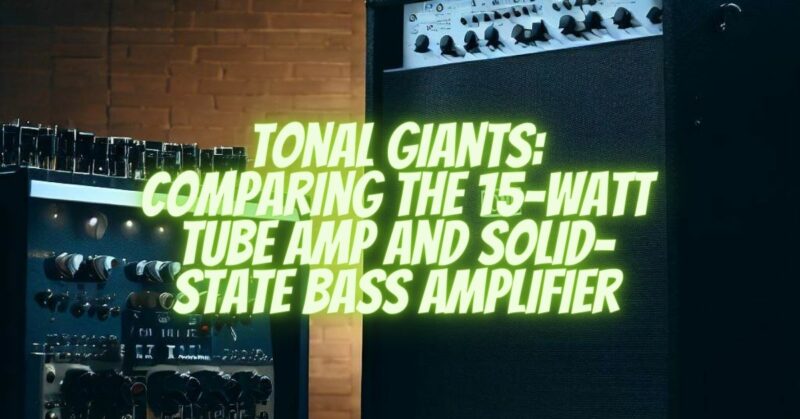When it comes to bass amplification, two primary contenders have dominated the market for years: tube amps and solid-state amplifiers. Each technology offers unique characteristics that cater to the needs and preferences of bassists worldwide. In this article, we’ll explore the differences, strengths, weaknesses, and tonal qualities of a 15-watt tube amp and a solid-state bass amplifier. By the end, you’ll have a comprehensive understanding of these two amplifier types, enabling you to make an informed decision based on your musical goals.
I. Unleashing the Warmth: 15-Watt Tube Amp for Bass
1. Tonal Characteristics:
Tube amplifiers are celebrated for their warm, organic, and dynamic tonal qualities. While commonly associated with guitar amplification, tube amps can also deliver exceptional tones for bass players. A 15-watt tube amp produces a smooth, rich low-end with a pleasant midrange presence, offering a classic and vintage bass sound.
2. Harmonic Richness and Overdrive:
Tube amps excel at producing harmonically complex overdrive tones when pushed to their limits. The natural compression and saturation they provide create a warm and smooth overdriven bass sound. The 15-watt tube amp’s lower power output allows for easier tube saturation at lower volume levels, making it suitable for recording, small gigs, and studio work.
3. Responsive Dynamics:
One of the standout features of tube amps is their dynamic response. They are highly responsive to the player’s touch, picking up nuances and subtleties in playing technique. This responsiveness allows for expressive playing and the ability to shape the tone with finesse, enhancing the overall musicality of the bass performance.
II. Harnessing Power and Precision: Solid-State Bass Amplifiers
1. Clean and Accurate Tones:
Solid-state bass amplifiers are known for their clean, accurate, and precise tonal reproduction. They offer clarity, punch, and a tight low-end response that suits a wide range of musical styles. Solid-state amps excel in delivering a transparent sound, faithfully capturing the nuances of the bass guitar and effects.
2. Power and Volume:
Solid-state bass amps, including those with lower wattages, can provide ample power and volume. A 15-watt solid-state bass amplifier ensures enough output to be heard in small venues, rehearsals, and home practice setups. The solid-state technology allows for consistent performance and volume levels without sacrificing tonal clarity.
3. Reliability and Maintenance:
Solid-state bass amplifiers are known for their reliability and durability. They do not require regular maintenance or tube replacements, reducing potential downtime and maintenance costs. Solid-state amps are less susceptible to physical shocks and temperature variations, making them well-suited for gigging musicians and those who require robust performance.
III. Comparing the Tone Titans: 15-Watt Tube Amp vs. Solid-State Bass Amplifier
1. Tonal Versatility:
A 15-watt tube amp offers a vintage, warm, and organic bass tone with rich harmonic complexity. It is favored by bassists who seek a classic sound associated with rock, blues, and certain jazz styles. Solid-state bass amplifiers provide a clean, precise, and punchy tone that suits various genres, including funk, pop, and metal.
2. Portability and Size:
Tube amps, due to their design and the inclusion of vacuum tubes, are generally larger and heavier than solid-state bass amplifiers. Solid-state amps, including 15-watt models, tend to be more compact and lightweight, making them easier to transport and better suited for musicians on the go.
3. Cost Considerations:
In terms of cost, solid-state bass amplifiers typically have
a lower price point compared to tube amps. Tube amps require periodic replacement of vacuum tubes, which can add to the overall cost of ownership. Solid-state technology has advanced significantly, offering budget-friendly options without sacrificing tonal quality.
Conclusion:
When choosing between a 15-watt tube amp and a solid-state bass amplifier, it’s essential to consider your musical preferences, playing style, tonal requirements, and practical needs. Tube amps deliver warm, harmonically rich tones with dynamic responsiveness, while solid-state amps provide clean, accurate tones with reliability and affordability. Assess the desired tonal characteristics, power requirements, portability, and budget to make an informed decision. Both tube and solid-state bass amplifiers have their strengths and can help you achieve your desired bass sound.


